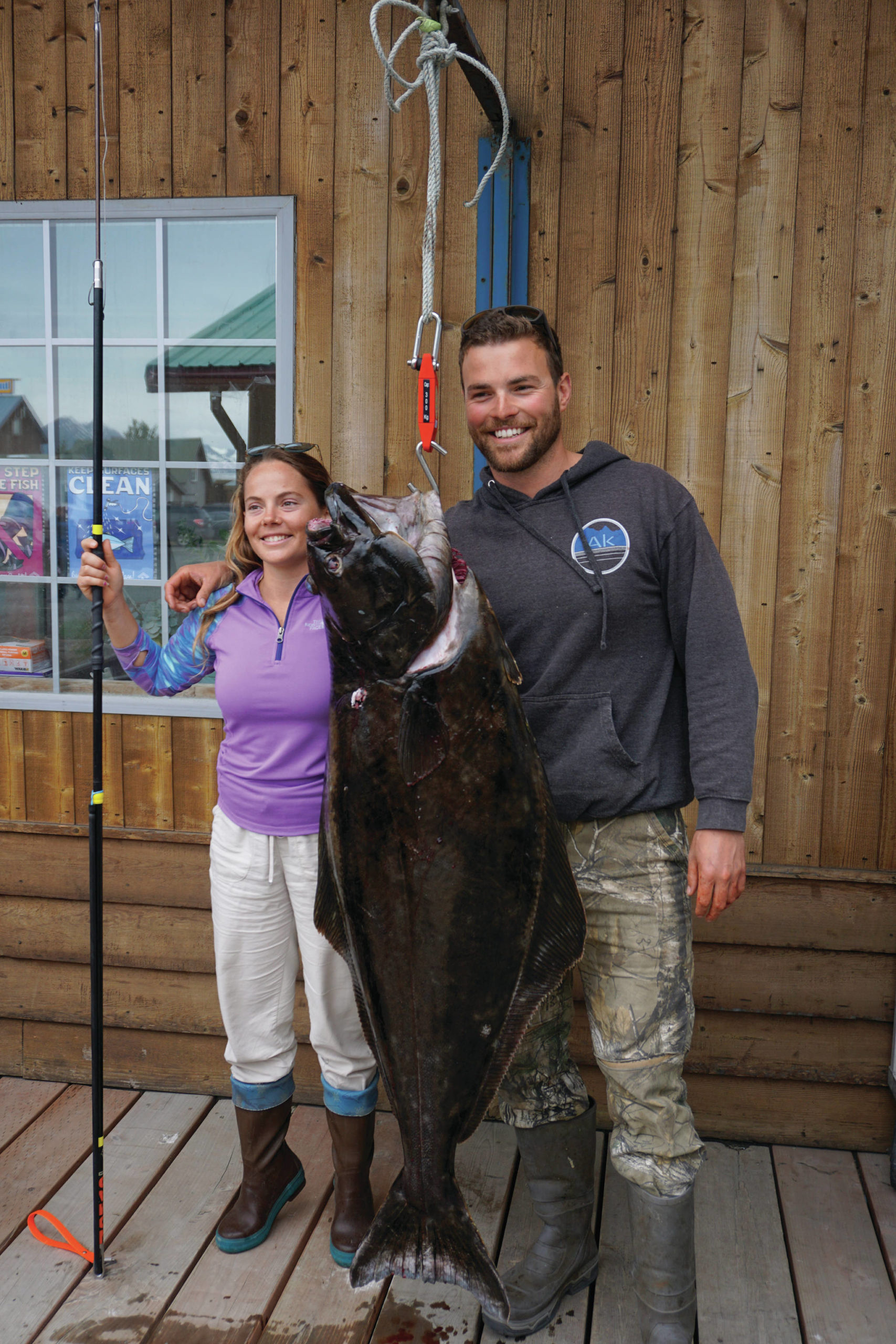An angler who pulls in with a rod and reel an almost 72-pound halibut might make a splashy social media post, but the big fish Lisa Stengel caught Monday gained distinction for how she took it, not just its size.
Stengel, 32, of Fort Lauderdale, Florida, landed her 71.4-pound Pacific halibut with a spear while free driving 25-feet deep in 45-degree water against a 5-knot current. If verified by the International Underwater Spearfishing Association, that feat will put her in the record books for the largest halibut caught by a woman using a sling pole spear.
Actually, there is no record yet for a woman who has caught a halibut with a pole spear, so Stengel didn’t just set the record, she’s “setting the bar pretty high,” said Brad Conley, co-owner with his wife, Lisa, of Coldwater AK, a Homer water taxi and guiding service that took Stengel and her friends out on a spearfishing expedition this month.
Stengel fished with captain Brian Reid on the Castle Cape. The largest fish of any species caught with a pole spear by a woman is a 66.1-pound black grouper.
“The hardest part was fighting the current,” Stengel said Monday afternoon as she waited to weigh her fish at Coal Point Seafoods. “You have to get a really good shot to hold him. It was a perfect shot — right in the head.”
Stengel’s halibut was almost as long as she is tall. While some people use spear guns to fish while free diving, Stengel got her halibut with more challenging gear, a sling pole spear with a slip tip, a small harpoon head that pierces the flesh of the fish. The angler pulls back on a big rubber band that wraps around the pole — the sling — and lets loose with the spear.
Attached by a short cable to the spear pole, the slip tip comes loose and holds tight in the fish. A modern adaptation of the centuries-old Inuit toggle-head harpoon, pulling back with the pole and line sets the slip tip. Stengel had her gear attached to a large buoy so it wouldn’t get lost if the halibut yanked it out of her grasp.
That’s part of the fun and challenge of spear fishing halibut, Conley said. Some of his clients have caught 100-pound halibut.
“You realize how humbling it is in the water with those big, powerful fish. They have so much torque and power,” he said. “… That’s what’s so neat about Lisa. She’s this tiny, petite lady. For her to take on a fish almost as big as her is an impressive feat.”
Conley called the difference between spearfishing and a pole spear like the difference between hunting with a rifle and bowhunting.
Once the fish gets speared, “from that point on it’s fighting it to the surface, I guess like rod and reel,” Conley said. “You’re in the water, your physical strength trying to convince them to come to the top. Those big fish, you bring them to the top and they’ll run on you, and you’re along for the ride.”
On top of that, Stengel caught her fish while free diving, or diving without scuba gear. In Alaska, free divers wear wetsuits with hoods, masks and snorkels, weight belts, and fins almost as long as a person’s legs.
Stengel said she got started in underwater diving with scuba gear and then started free diving. She has fished in south Florida for wahoo and other species.
“This is way less gear,” she said of free diving. “I like it better.”
Coldwater AK has carved out a niche in the halibut charter fleet. Conley, Reid and some other locals have become experienced free divers and spear fishermen. Some will dive for up to two minutes in 100 feet hunting for rockfish.
As a guided halibut sport-fishing operation, Coldwater AK functions just like the more traditional rod-and-reel fishery.
“As far as everyone is concerned, we’re going out fishing like every other halibut charter, just doing it a little bit differently,” Conley said.
Other charter captains have been encouraging about Coldwater AK’s fishing technique.
“Because of the way we’re doing it, they know we’re not competing with them,” Conley said. “They know we’re not going to clean out an area. We’re in the kelp beds and the shallow waters.”
Stengel works as a first mate for a private yacht. She first came to Alaska on a trip to Southeast.
“When I did that, I said, ‘I want to fish up here,’” she said of that visit.
She came up with a group of friends from Florida. Conley said her group is typical of the kind of clients he sees — experienced free divers who want to explore Alaska waters. That takes some getting used to, he said.
“Alaska is an extremely challenging place to dive. It’s not just cold water. It’s currents,” he said. “… A lot of the divers are extremely capable divers, but it takes them two or three days to get accustomed to the water. … Things start clicking. Suddenly they’re shooting big fish.”
Reach Michael Armstrong at marmstrong@homernews.com.

